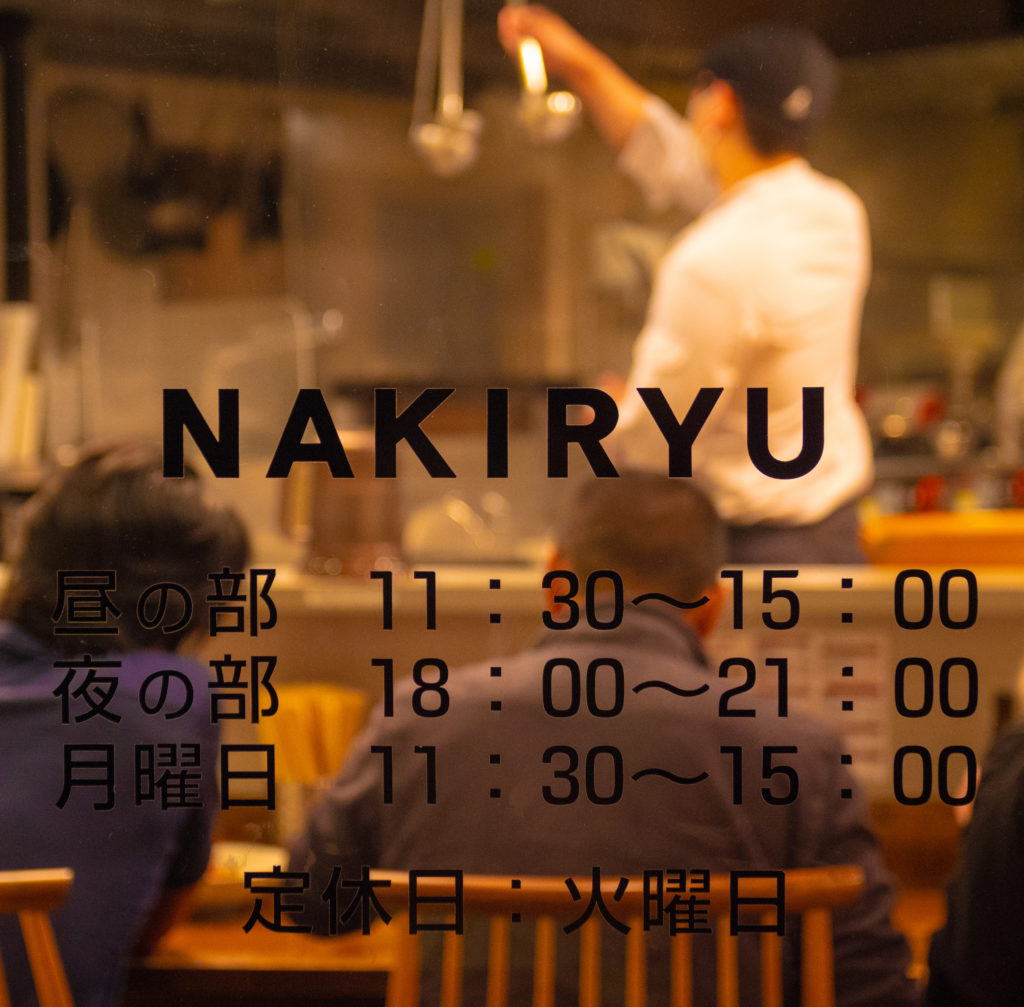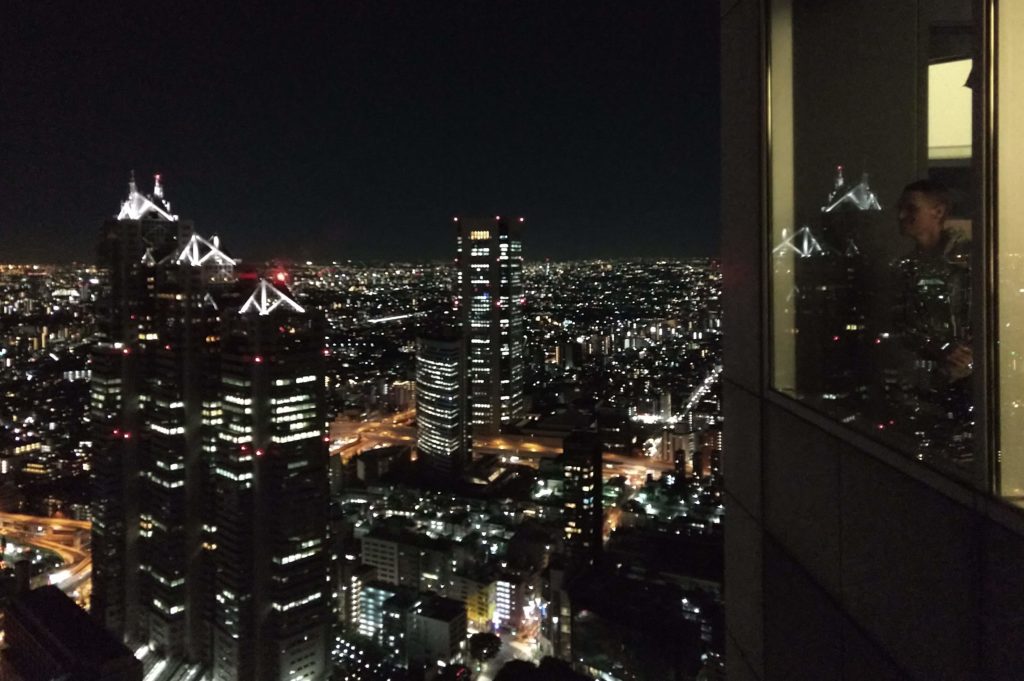Tokyo may be the most wonderfully strange, utterly magical city in the world. From hyper-efficient public transit to fun modes of serving food to throngs of people wearing suits to beautiful parks and temples to the shining city lights at night, we LOVED it.
It doesn’t hurt that Tokyo is the capital of the most likeable country in the world, Japan. We love the mix of tradition and technology, the politeness and efficiency, the emphasis on hygiene (ok, that’s more appealing to me than Chad), and the way things just work. It also doesn’t hurt that we’re visiting in late spring (May), so the weather is PERFECT. The ONLY downside we can think of so far is that it is definitely more expensive here than most of the countries we visit.
Arrival in Tokyo and Ginza
We took an overnight flight from Thailand and arrived at about 8 a.m. having caught some decent sleep on the plane. Clearing the border and customs was easy and efficient and right away we saw the counter to buy our transit tickets I had researched – a combo one-way pass for the Skyliner from Narita Airport to downtown and 72-hour metro pass. We easily reached our hotel in Ginza by 10:00, where they stored our suitcases so we could explore our new neighborhood for a few hours.
Ginza is a central business district for Tokyo, so lots of skyscrapers and business-friendly restaurants. We were immediately struck by the amount of people walking around in suits. No business casual here! We decided to first walk down to Tsukiji Fish Market, which is apparently now more of a tourist destination than functioning fish market. It was fun to see the crazy street foods on offer, though we weren’t tempted to buy anything because it was about 8 times more expensive than Thailand street food. After the fish market, we walked up to Tokyo Station to buy our bullet train tickets to Hiroshima for Saturday and eat lunch at Tokyo Ramen Street, which is in the basement of the train station (outside of where you need a ticket to enter). These eight restaurants, like most ramen restaurants in Japan, operate through a system where you purchase your food through a vending machine and are given a ticket to hand to the server when you get your table. We chose at restaurant at random based on where there was a table available, rightly assuming that all the places would have awesome ramen.

With just a little more time to kill we tried to visit the Imperial Palace Gardens, but it was closed in continuation of the holiday (we arrived the day after the end of Golden Week). But we were able to see a little of the grounds and enjoyed people-watching from a bench before finally being able to get into our hotel room for a much-needed rest.

grounds of Imperial Palace 
Imperial Palace moat 
the grounds abut a normal modern business district
That night we ventured out to the neighborhood of Akihabara, called Electric City for our first taste of Tokyo “neon.” It was pretty epic. I’ll let the photos do the talking.

Akihabara 
game place in Akihabara 
gaming place
Yanesen, Ueno Park, and Asakusa
The next day we focused on the area north of Tokyo station, starting with a morning walk in the charming old neighborhood of Yanesen with its tiny winding streets and pre-WWII buildings. We enjoyed the Nezu Shrine, Yanaka Cemetery Park, and really just wandering through the little streets.
From there we walked down to Ueno Park, which is Tokyo’s main park of museums and the zoo. The Museum of Western Art building was designed by Le Corbusier and the park itself was fun to sit in and people watch, especially the large groups of school kids. We decided we weren’t in the mood for a museum, so we left Ueno Park and went by metro to the Asakusa neighborhood for Nakamise Shopping Street and Sensoji Temple, then walked along the Sumida River. For lunch, we had our first conveyor belt sushi experience, which was as fun and interesting as it sounds.

shopping street 
5-tier pagoda at Sensoji Temple 
conveyor belt sushi 
our lunch feast – each plate costs 100 yen
After a rest break, we went out for dinner at a German beer hall (sometimes you just want western food!) and then out for the nightlife of Shibuya. The lights were again very impressive, and subtly different from what we’d experienced in Akihabara. This is the site of the “scramble crossing” with throngs of people day and night crossing the street in six directions. But the highlight was drinking at a hole-in-the-wall bar in Nonbei Yokocho, which Google aptly describes as “narrow, lantern-lit alleyways & drinking district lined with small izakaya pubs & restaurants”. The drinks were pricey (on top of a “seat charge” of 600 yen a piece) but we had a really nice time conversing with the bartender and other travelers.
Parks and Stars

The next morning we went back to Shibuya, this time to visit Yoyogi Park (by way of Harajuku Street, just to check it out briefly). It was really pretty, especially the shrines. I’ve learned about the Japanese concept of “forest bathing” in mindfulness books (the idea that spending time in the woods is therapeutic; certainly true for me!), and the park with its tall trees and lush greenery made me think of that concept. We then went to lunch at a Michelin-star restaurant called Nakajima (a continuation of my Christmas gift from Chad of cheap Michelin star meals in Asia). They had three relatively inexpensive set lunch options to choose from featuring sardines, so Chad chose sashimi, while I had mine in a sauce. It was very tasty, I’d definitely recommend Nakajima. Also, it was a completely different atmosphere than the food stall Michelin-star places we visited in Singapore. You could tell their dinner service is super-upscale so lunch felt like an amazing value.

After lunch we wanted more time in nature, so we visited Shinjuku Gyoen National Garden. Gardens generally charge a small admission fee in Japan (usually around 500 yen) and this was no different, but it was certainly worth it. Very beautiful grounds and we noticed for the first time the trees with aerial roots. Then we returned to our hotel for a break.

Shinjuku Garden 
aerial roots

That evening we went out that night to Bar 300 near our hotel that we’d discovered on our first night, where everything (seriously) was just 300 yen (around $3). You purchase a set of tickets as you enter each valued at 300 yen and exchange them for any drink of food item. This ended up being one of our favorite parts of staying in Ginza, because it can be a challenge to eat and drink cheap in Tokyo. After some very Japanese snacks and drinks, we took the metro quite a ways north to another Michelin-star meal, this time at a ramen restaurant called Nakiryu. The snacks came in handy because there was a long queue. There are only 10 seats inside the restaurant. However, it operates via vending machine like the other ramen restaurant we visited, so people moved in and out pretty quickly. We waited about 45 minutes and it was completely worth it. Fantastic ramen.

300 yen bar duck and mushroom with cheese 
Nakiryu entrance with chef hard at work 
examining the Michelin stars 
best ramen
After dinner we managed to make it to the Observation Tower at the Tokyo Metro Government Building just in time before they stopped letting people up for the night (I believe at 10:30). This is a great free thing to do, with a view from 200 meters up and especially nice at night. So close to closing, there was no line and we enjoyed looking out across all the Tokyo lights.

Odaiba Island
For our final day in Tokyo, we enjoyed an easy morning before walking over to Hamarikyu Garden near our Ginza hotel. This was another lovely garden that was a former imperial duck hunting grounds and we really enjoyed our morning wandering around.
Around lunchtime, we took the train to Odaiba Island and had a little picnic from the Family Mart, and then went to Maraiken, the National Museum of Emerging Science and Innovation. It was a bit of a disappointment, but they had some interesting exhibits with robots and androids. Though wearing out from four straight days of sightseeing, we managed to stay in Odaiba until dusk so we could see its more famous sights (i.e. the transformer, statue of liberty replica and the bridge) light up by caffeinating at a cool Vegas-y mall (called Venus, but was Venice-themed) and visiting the Panasonic Showroom.

Osimo android demonstration at Maraiken 
Geminoid F android (we later met one!) 
Chad and android 
coffee at Venus Fort mall 
NES exhibit in the Panasonic showroom 
Transformer! 
Odaiba Island at dusk 
Odaiba Island at dusk

We then took the train back to our neighborhood, where we got some fantastic Japanese curry at a restaurant called Camp Curry, which was camping themed and one of my favorite meals in Japan. We were surprised to find yet another lit up neighborhood along the lines of Shinjuku, Shibuya and Akihabara right near our place in Ginza. We were glad we went out each night because each these neighborhoods had a completely different feeling to them in how the signs and lights were presented.
Overall we absolutely loved our time and Tokyo and definitely want to come back. Ginza was a great choice to be our home base neighborhood and our whole experience in Tokyo was the perfect introduction to our time in Japan.

Tokyo lights 
Tokyo lights
Review of Hotel Musse Ginza Meitetsu – Great hotel for a short stay.
This hotel was a great home base for our 4-night stay in Tokyo. We booked the larger double room, which was a great size and we felt the hotel was an excellent value for the money. It is convenient to the Ginza metro station, which was perfect for us because we used a three-day metro pass to get around the city sightseeing. It was also convenient to the train station to go to Odaiba Island, which we did after our metro pass expired. The front desk was kind enough to store our luggage on the day we arrived. When we left we decided we didn’t want to haul our luggage to the train station and it was easy to get a taxi right outside the hotel. I definitely recommend this hotel.




One Comment Add yours